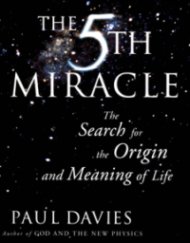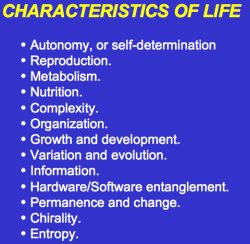Page 4 of 7
The Fifth Miracle
Figure 4 is a reproduction of the front cover of Paul Davies' book called The Fifth Miracle.

Figure 4
Much of what I'm going to talk about when I describe the characteristics of life originates from this book. This is a book about astrobiology and it's one of the first ones that I read. It’s a very good one. Davies is an interesting writer. He is a physicist by training, influenced by Schrodinger (who is mentioned in this book). Davies has named this book The Fifth Miracle because, according to his count, the fifth event of the biblical creation story was the first act that created life and plants, fruits and seeds and so forth.
This particular book is quite a scientific book, but Paul has written on both science and religion. In fact, he received the Templeton Prize, which is a highly valued award for thinking and writing on science and religion.
Unpredictability
Figure 5 is list taken mostly from Paul’s book. I've added or changed a few little things.

Figure 5
Number one is this notion of autonomy and the best way to describe that is to give an example like Paul Davies does when he said, "If you take a dead chicken and throw it up in the air, you have a pretty good idea where it's going to land. But if you take a live chicken and throw it up in the air, it's a little hard to predict where it's going to go." It may fly off some distance; it may go back to the coup; it may go to the limb of a tree if it's an active chicken. So there is an unpredictability about life. Life has life of its own. You know, you talk to the dog and you ask him to do something, he very often does something quite unpredictable. So there is a notion of autonomy that is inherent in the individuality of living things.
Reproduction
The second item is reproduction and implies not only reproduction - the entity itself - but the reproduction of the means of reproduction so that it can produce itself and reduce the means of producing itself. A lot of things that we consider alive don't actually have this capability. For example, mules are living, but they can't reproduce. You have to make a hybrid each time. And viruses, which many people, including myself, consider it to be alive require cells from another organism in order to thrive.
Also, there are some objects that we consider to be inanimate, such as crystals, which reproduce themselves or reproduce out of a mother liquid. Or consider forests and bush fires. They reproduce. You start off with one fire and you end up with many. Cloud formations have a way of reproducing. So the fact that something can reproduce itself by itself is not sufficient as a definition.
1 2 3 4 5 6 7 next page>